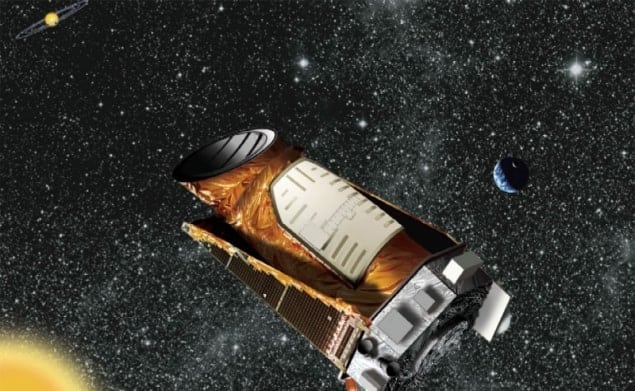
A Sun-like star with six orbiting planets has been discovered by the Kepler spacecraft in what NASA researchers are proclaiming as the biggest discovery in their field since the first exoplanet was discovered in 1995.
The six new planets have been located over 2000 light years from Earth orbiting a star roughly the same size as our Sun, which has been named Kepler-11. The planets were discovered by the transit method, which can detect a slight dimming in the light of a star as a planet sweeps across our line of vision from Earth. Prior to this finding, only one star was known to have more than one orbiting planet – Kepler-9, discovered last year, which has two confirmed planets and possibly a third.
We think this is the biggest thing in exoplanets since the discovery of 51 Pegasi-b Jack Lissauer, NASA Ames Research Center
Five of the planets orbit closer to their star than any planet does to our Sun, with orbital periods between 10 and 47 Earth days, making this by far the most densely packed planetary system yet discovered. The orbit of the sixth planet, if placed within our own solar system, would reside between the orbits of Mercury and Venus.
“Because it was so unexpected and we’re getting so much information out of this system, we think this is the biggest thing in exoplanets since the discovery of 51 Pegasi-b, the first exoplanet back in 1995,” says Jack Lissauer of NASA Ames Research Center, California, who led the study.
Dimming starlight
By measuring the “depth” of each transit, which indicates how much starlight dims due to a transiting planet, the researchers were able to calculate the mass and radius of the each planet. In this way, they were also able to obtain the bulk density of each planet, which is already yielding clues to their compositions.
The six planets range in size from twice Earth’s radius to more than four times as large as Earth, and the researchers describe them as being relatively “puffy”, having fairly large radii for their masses. They suggest that the planets probably lie somewhere between the densities of Earth and Neptune, and the inner two planets may well be made from rock and water with a steam atmosphere.
However, they warn against making comparisons with Earth at this stage. “We’re still learning how nature makes planets in this intermediate mass range,” says Jonathan Fortney, one of the planetary composition specialists on the NASA team, based at the University of California, Santa Cruz. “It is clear that such planets need not resemble the Earth in any way, which adds to our incredible planetary diversity”.
Fortney adds that having so many planets in the same system will provide a unique opportunity to learn more about the geological evolution of individual planets, just as astronomers have compared planetary histories within our own solar system. The host star, Kepler-11, is older than the Sun, estimated to be 6–10 billion years old.
‘Absolutely stunning’ result
Suzanne Aigrain, an astronomer from Oxford University in the UK, who was not involved in the research, describes the new finding as an “absolutely stunning” result and agrees that many more details of individual planets will be revealed as Kepler continues to monitor the system. She also suggests that more specific details about planetary atmospheres could be discovered by looking at the spectrum produced by individual transits usng space, or possibly ground-based, observations.
The NASA researchers admit a degree of luck with this discovery because the transit method only works when the observer is located near the plane of an exoplanet. “Just because one planet in a system is observed to transit from a particular vantage point, doesn’t imply that all planets will transit viewed from the same perspective,” says Lissauer. He estimates that, for this reason, the Kepler-11 system could therefore be a one-in-10,000 solar system. “The Kepler-11 system is flatter than a CD. An old vinyl record would actually be a better analogy to the scale model of the planetary system we are seeing,” he says.
Lissauer believes that the surprising stability of the planetary system given the proximity of the planets to the star is due to damping effects shortly after the planets had formed. This, he speculates, could have been mediated by gas, or planetoids like between Mars and Jupiter in our own solar system. “But it had to have been lots of them in order to slow down eccentric motion and get them into a nice calm state that could last for billions of years.”
The researchers also speculate that a seventh planet could be residing between the orbits of the fifth and sixth planets, given the size of the gap and preliminary observations of the gravity effects between planets. This is a view shared by Carole Haswell of the Open University in the UK who is confident that other planets may well be found. “If there are such planets in the system, detailed analysis of the dynamics over a long timescale might allow them to be indirectly detected,” she says. “There could also be longer period transiting planets present which Kepler has not yet seen a transit of.”
The discovery is detailed in a paper in Nature.




